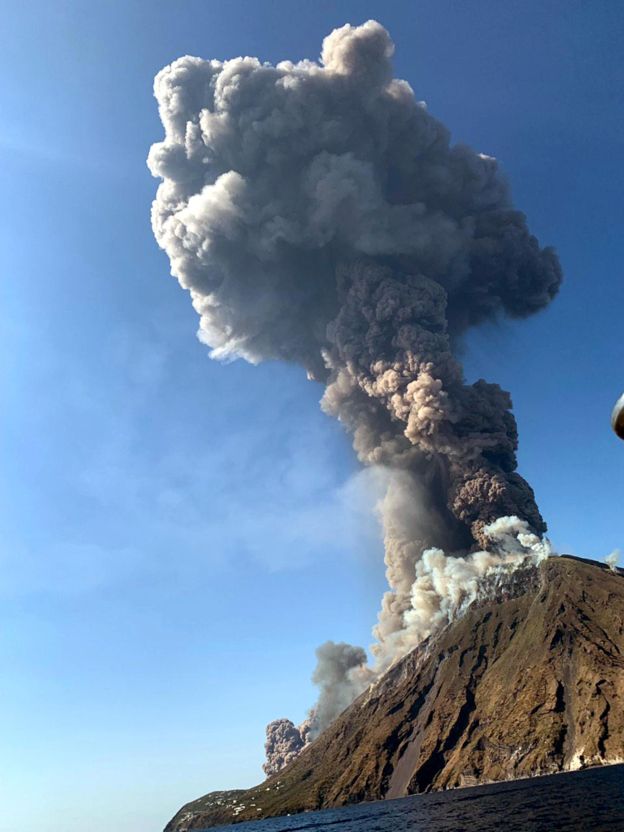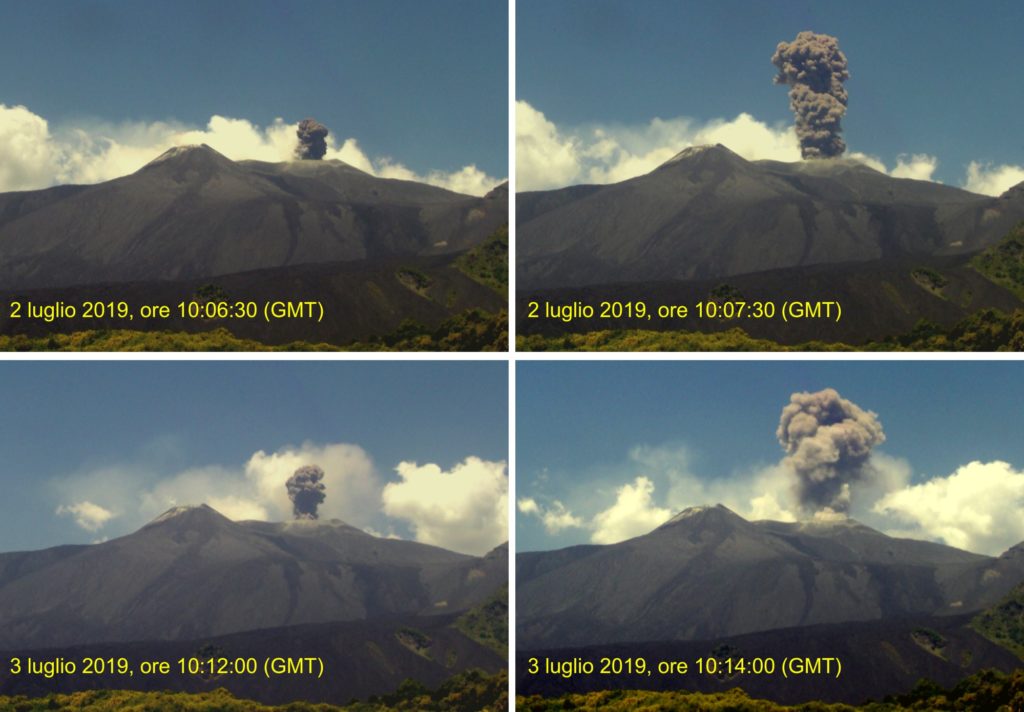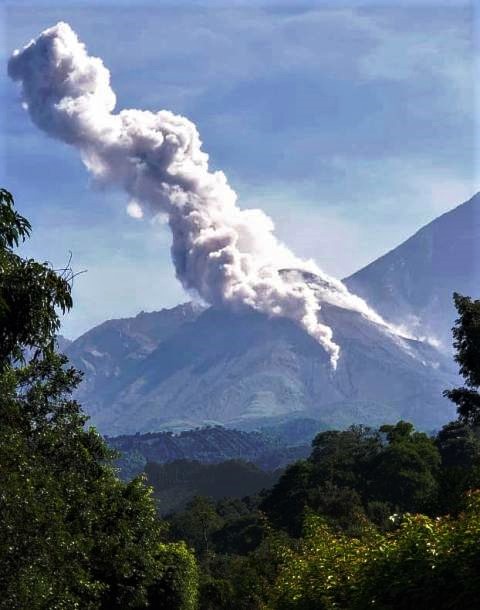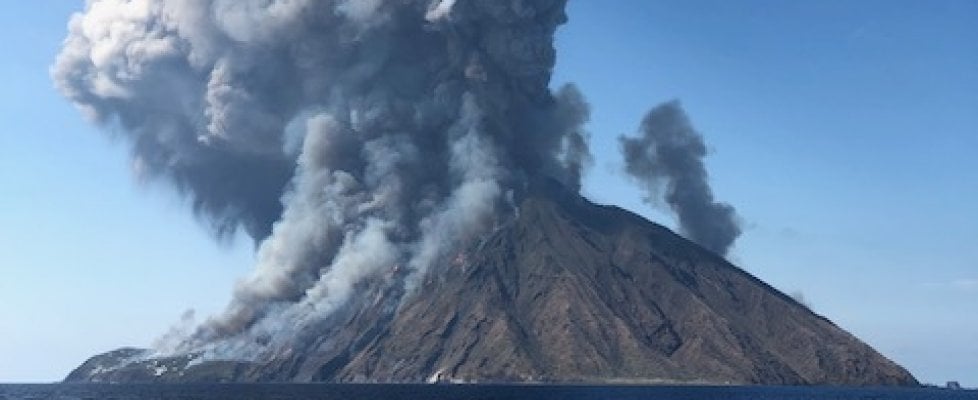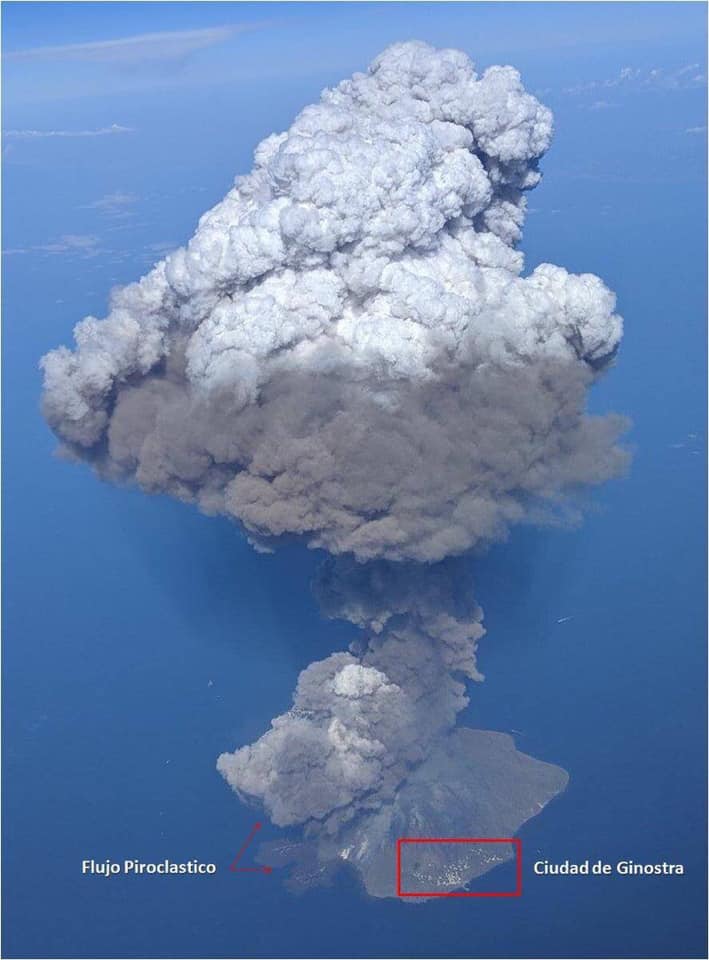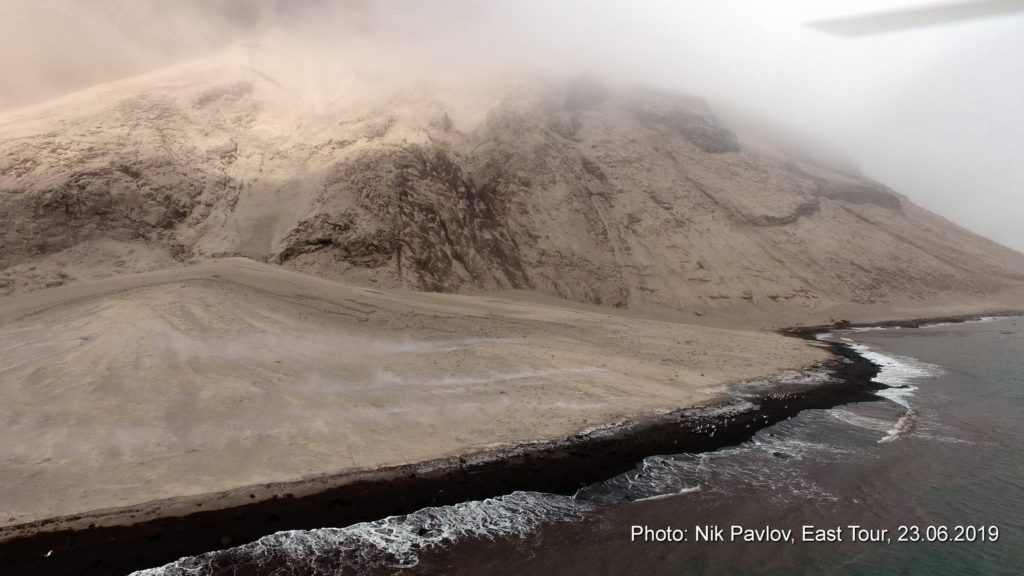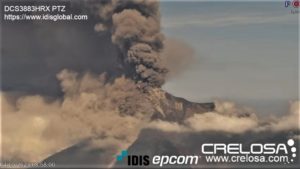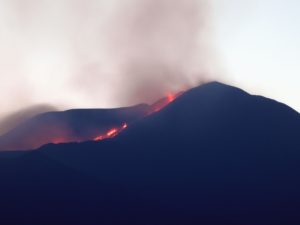July 04 , 2019.
Italy / Sicily , Etna :
EXPLOSIVE ACTIVITY AT ETNA’S NORTHEAST CRATER –
Exactly 24 hours after yesterday’s explosive activity at Etna’s Northeast Crater, a new explosion has been observed at the same crater by the video surveillance cameras of the INGV. Also in this case, the emitted ash was rapidly dispersed in the summit area. The event was not accompanied by any significant variation in the volcanic tremor amplitude
The images were recorded by the high-resolution surveillance camera at Monte Cagliato, on the eastern flank of the volcano at the lower end of the Valle del Bove. The upper two show the explosion of 2 July, the lower to the explosion of 3 July 2019.
These two explosions (probably caused by the pressure of steam inside a largely blocked conduit, not by rising magma again), are almost identical and almost in the same schedule on July 2 and 3, 2019. This is the northeastern crater, the highest of the four summit craters of Etna, which for two days had already been producing large and dense white puffs.
Source : INGV Vulcani. DR. Boris Benhcke.
Guatemala , Santiaguito :
SPECIAL VOLCANOLOGICAL BULLETIN: ACTIVITY OF THE SANTIAGUITO VOLCANO Guatemala 2 July 2019, 22:45 (local time).
Activity type: Pelean
Morphology: Complex of dacitic domes
Geographical location: 14 ° 44 ’33 ˝ Latitude N; 91 ° 34’13˝ Longitude O.
Altitude: 2500msnm.
Over the last 2 years, Santiaguito volcano has shown a low tendency to eruptive activity, recording between 10 and 15 weak explosions per day, consisting mainly of water vapor and little ash.
On June 28, 2019, on the basis of the recording of seismic stations STG3, STG0, STG8 and OVSAN information, it was recorded on volcano changes in seismic activity, consisting of a gradual increase in the number and explosive energy, recording about 35 to 40 per day . They are classified as low to moderate, emitting columns of ash reaching heights ranging from 3,500 to 3,800 meters (11,480 to 12,465 feet), dispersed to the south and southwest with fine particles of ash falling over the Patzulín and El Faro fincas; and the villages Horizontes, Las Marias, Loma Linda, San Marcos Palajunoj and some others located in this area.
Due to the extrusion of magma into chaotic stacked blocks, instability is generated in the domes of the volcanic complex, causing avalanches to the Southeast, South, and Southwest flanks. These avalanches have been classified as weak to moderate generating ash particle clouds on their way to the base of the dome.
Due to the change in explosive behavior and recorded avalanches, it is possible that moderate to high explosions generate pyroclastic flows. It must also be considered that avalanches cause instability in the structure of the Caliente dome, which could lead to a partial collapse of the dome, and generate pyroclastic flows to the south-east, south and south-west flanks.
Source : Insivumeh.
Photo : Conred.
Italy , Stromboli :
COMMUNICATION ON THE VOLCANIC ACTIVITY of 03 July 2019, 15:16:39 (UTC) – STROMBOLI.
The National Institute of Geophysics and Volcanology, Osservatorio Etneo, announces that the surveillance networks recorded a high intensity explosion at 17:16 (15:16 UTC).
From 14:46:10 UTC, a paroxysm occurred that affected the south-central area of the Stromboli crater terrace. In particular, two main explosive events were distinguished at 14:46:10 and 14:46:40 UTC respectively. The sequence was preceded at 14:44 UTC by lava splashing from all the active mouths of the crater terrace. The INGV field staff observed an eruption column rising at least 2 km above the summit area and dispersing to the southwest. The products generated by the paroxysm fell on the sides of the volcano. The phenomenon in question is also visible on the seismic trace, which indicates in addition to major explosions about 20 minor explosive events. After the paroxysmal phase, the tremor signal decreases.
Violent explosions on Stromboli, tourists in the sea.
Falling lapilli causes fires in the reed area. Canadair in action to extinguish fires. Firefighters: « Just panic, no one is hurt right now. »
A two-kilometer eruptive column occurred on Stromboli, which released lapilli of different sizes on the craters that triggered a series of fires. And panic broke out in Ginostra where inhabitants, assisted by the civil protection, leave the houses spontaneously. Others barricaded themselves at home for fear of lapilli. Some tourists have also jumped into the sea. There are no injuries warned the firefighters. « One of the biggest explosions recorded on Stromboli ».
This is how experts from the National Institute of Geophysics and Volcanology call the explosion recorded at 16:46. Fires broke out in the reed area. Experts say that before the blast, there was « two splashes of lava » that spilled onto the Sciara del Fuoco. « Since 14:46 and 10 seconds UTC, a paroxysm has hit the center-south area of the crater terrace where the vents of Stromboli open, about 800 meters above sea level », explained the volcanologist of the observatory Engv- Etneo, Marco Neri.
The regional room for civil protection operations was immediately activated after the Ingv reported a series of violent explosions on Stromboli. According to the first information gathered during the explosion by the Forestale , the carabinieri and the firemen, the fall of incandescent materials would have provoked a series of fires in different zones of the island. « I am in contact with the head of the Regional Civil Protection, who is constantly informed about the situation on the island of Stromboli, » said the president of the Sicilian region Nello Musumeci in a statement.
« We have reports of several fires caused by the violent explosion of the volcano, but we have no information of wounded or involved, but only fear for the fall of lapilli. There were fears for those who were in the highest areas.We have already organized, in terms of our competence, the rescue mechanism with firefighters sent with the coast guard and a helicopter from Lamezia Terme « .
COMMUNICATION ON THE VOLCANIC ACTIVITY of 03 July 2019, 18:31:07 (UTC) – STROMBOLI.
L’Osservatorio Etneo, of the National Institute of Geophysics and Volcanology, reported that the monitoring networks had recorded the return of the parameters to normal activity at 20:31 (18:31 UTC).
After the paroxysm of 14:46 UTC, no other high intensity explosive event was observed. The seismic trace returned to the levels preceding the explosion sequence and, thanks to the surveillance cameras, it was possible to observe a normal strombolian activity and the cooling of the materials deposited along the Sciara del Fuoco, which produce a rolling continuous towards the coast. The Stromboli GPS network, at present, does not show any significant variations. However, it should be noted that during the paroxysmal explosion phase, the high frequency processing system measured large variations due to the GPS frequency perturbations induced by the abundant amounts of ash transients or low frequency deformations. One of the GPS stations (STDF – Timpone del Fuoco, Ginostra), a few minutes after the explosive sequence, stopped working. Further details are underway regarding the data and causes of the STDF station failure.
https://www.facebook.com/LGS.LaboratorioGeofisicaSperimentale/videos/696948107409551/
The stations of the inclinometer network (Punta Labronzo and Timpone del Fuoco), after the variations registered between 14:45 and 14:49 UTC, do not show significant variations in the following hours. The dilatometric signal recorded at the SVO station showed significant variations before the event which started around 14 h 38 UTC approximately, to gradually return to the normal level. Finally, the flow of SO2 measured through the FLAME network did not show any significant variations in the days preceding the explosion and in today’s day, remaining under a medium to low degassing regime compared to typical features of Stromboli.
COMMUNICATION ON THE VOLCANIC ACTIVITY of 03 July 2019 19:08:10 (UTC) – STROMBOLI.
The National Institute of Geophysics and Volcanology, Osservatorio Etneo, announced that following the improvement of the visibility of the summit area, it was possible to observe from the images of the cameras of the surveillance network, the presence of a modest lava overflow currently confined to the upper part of the Sciara del Fuoco. From the lava front, large incandescent lava blocks reach the coast.
REPUBLICA announces the death of a man from Milazzo who was on a road in the Ginostra area, his Brazilian friend is unscathed. Two others injured.
Source : INGV Vulcani , La Reppublica ,
Vidéo : 6ninjak , LGS.
Photos :Quotidiano .net , Jochen Felkl.
Russia / Kuril Island , Raikoke :
48.292°N, 153.25°E
Elevation 551 m
SVERT and KVERT reported that during 25 June-1 July steam-and-gas plumes with ash rose 1.5-2 km above Raikoke and drifted WNW based on satellite images. The Aviation Color Code was lowered to Yellow on 25 June and then to Green on 27 June.
A low truncated volcano forms the small barren Raikoke Island, which lies 16 km across the Golovnin Strait from Matua Island in the central Kuriles. The oval-shaped basaltic island is only 2 x 2.5 km wide and rises above a submarine terrace. The steep-walled crater, highest on the SE side, is 700 m wide and 200 m deep. Lava flows mantle the eastern side of the island. A catastrophic eruption in 1778, during which the upper third of the island was said to have been destroyed, prompted the first volcanological investigation in the Kuril Islands two years later. Reports of eruptions in 1777 and 1780 are erroneous (Gorshkov, 1970). Another powerful eruption in 1924 greatly deepened the crater and changed the outline of the island.
Sources : SVERT , GVP.

